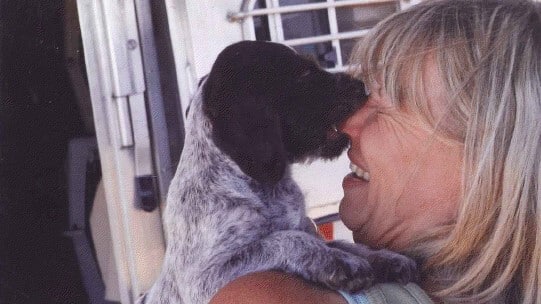Interview with Judy Cheshire, Breeder of Heywire German Wirehaired Pointers
- Please tell us a little bit about yourself. Where do you live? How many years in dogs? How many years as a breeder? What is your kennel name?
- What is your “process” for selecting show puppies? Performance puppies?
- In your opinion, is your breed in good condition overall? Any trends that warrant concern?
- As a Preservation Breeder, can you share your thoughts on the sport today? How’s the judging these days? What do you think about the number of shows?
- In your opinion, is social media good for the sport? Is it harmful?
- What are the biggest challenges facing the dog show community as a whole today and how can these be addressed?
- What are some of the positive changes you’ve seen in the sport over the past decade?
1. I have been involved in German Wirehaired Pointers since the early 1970s. I always loved the sport of dogs, and prior to GWPs I showed a few dogs in Obedience. At a dog show, I saw a GWP bitch called CH Hilltop’s SS Cheesecake, owned by Pat Laurans and shown by Joy Brewster. It was love at first sight, even though I knew nothing about the breed! “Racket,” as she was known, had an amazing presence and attitude that couldn’t be ignored. She became the first Best in Show bitch in the history of the breed. I introduced myself to Pat and Joy and told them I wanted a puppy. They had other plans for Racket, and although I finally prevailed, I waited several years before they had a puppy that they were willing to let me have! It was worth the wait because Pat and Joy and Racket’s breeder, Betty Stroh, proved to be wonderful mentors and shared an incredible amount of knowledge about the breed, pedigrees, history, and dogs in general with me. My husband has also been a big influence of my breeding program. We were both involved with GWPs before we became a couple, and having six Dual Champions, he taught me a lot about how form follows function in this breed. I breed under the Heywire prefix, and together, we have bred multiple Dual Champions, Best in Show dogs, and National Specialty winners. I have become an AKC Platinum Breeder of Merit and still occasionally breed or co-breed a litter. We both got our first GWP in 1976 and haven’t stopped loving the breed since! I’ve had GWPs while living in several areas of the country. I started in New York, moved to Washington state, and now we are in North Carolina. Fortunately, each of those regions has strong dog sport communities, with the Northeast being strongest in Conformation events and the Pacific Northwest dominating the field. I have always been a believer in linebreeding, realizing that sooner or later you have to go out for certain traits that you need in your line and to preserve the health and longevity of your dogs. I have to say that many of the breeders who came before us have laid excellent and important groundwork that has made our breeding program easier!
2. When we breed a litter, the plan is always to keep something from it. If showing a puppy in Conformation is the primary goal, we evaluate structure, type, proportion, and balance, and we also look at temperament. We ask ourselves if the puppies have the qualities that we were expecting from this litter and if the puppies are relatively consistent. If our goal is for performance, we still evaluate all of the above but might put a little more emphasis on attitude, boldness, and eagerness to please.
3. In my opinion, I think the breed is in good overall shape right now. There are some very responsible breeders who are trying to maintain both the correct conformation and the field capabilities of the breed, and who are interested in health testing and placing their puppies in the right homes where they will thrive.
4. We are and always have been a “low entry” breed as far as Conformation goes. There are some very good judges and some who are not as good, but they usually want to learn about a breed and it’s difficult if they see very few of them. Parent clubs have good judges’ education available and most breeders are very willing to mentor those who are trying to learn. But the GWP is meant to be a versatile breed and is also very adaptable. They can excel in Agility, Obedience, Rally, Scent Work, Tracking, and most of the sports that AKC offers! Are there too many shows? I think that, in general, the answer to that is in your personal perspective on shows. Where do you live in the country? How long are you willing to travel to go to a show? How often do you want to show? There are many more clusters and that can be very convenient. The addition of Group Club shows is also something we didn’t have years ago. But, although I read articles about too many shows, I don’t really hear exhibitors complaining about it.
5. Social media can be a double-edged sword! It’s an excellent vehicle to get information out quickly and is far-reaching, and it can also keep many people in touch with one another. But there are some who abuse it, and it can spread misinformation and be hurtful.
6. One of the challenges I see facing the dog show community is the loss of viable and affordable venues to hold their events. Clubs need to work together cooperatively, and it’s definitely not an easy problem to solve!
7. I think there have been some positive additions to the sport. The NOHS program has thrived and continues to grow! Junior Showmanship has expanded to many more of the sports and we see more and more Juniors active in clubs, which is very important! Hopefully, the positivity of participants will continue to outweigh the negativity!








